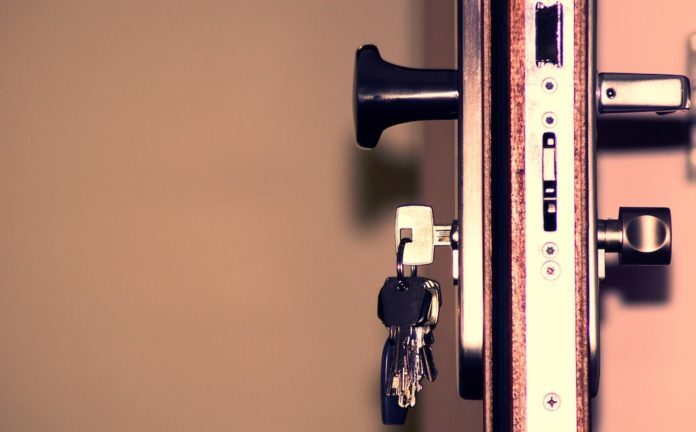Opening doors is more than just a metaphor for moving forward. Sometimes, you truly need to open a door. And sometimes that door is locked.
You might be surprised at just how often the skill of unlocking doors can come in handy once you have it. I recently lost a key to a cupboard and I haven’t bothered looking for it. I just pick the lock.
I can honestly count the number of times I’ve needed these skills in the U.S. on one hand. The truth is that they’re rarely needed because we have systems of support, such as cell phones and locksmiths. But it doesn’t take much for an event to overload the cell system, and that locked-in toddler becomes a true life or death situation.
As with other rights, the ability to open locked doors comes with the responsibility to do so morally. Don’t just go opening people’s doors without permission. But you should have the skills in case you ever need them.
Even if you don’t want to learn to open doors, you need to know these techniques. While most criminals will look for an easier approach, many will use these techniques to enter your home. If nothing else, after reading this, you should be able to better understand your own home security.
So how do you get through that locked door?
Your creativity is the only limitation when it comes to bypassing locks. I’ve driven through gates, shot through doors with a shotgun, kicked open doors, and applied a variety of different charges using det cord (detonating cord). But I’ve rarely used any of these techniques in a real-world environment. Because of false claims and bad intel, we had to keep the damage to a minimum. We didn’t want to turn into someone else’s retaliation tool.
What we’d normally do to gain entry was find the owner and have him open the door. Boots, bolt cutters, and sledgehammers were always on hand just in case the owner didn’t want to cooperate.
But then, there were those special occasions where we didn’t even want the owner to know we were there. In fact, because you aren’t likely to have an infantry platoon at back, you may find that the less destructive means are the best ways of getting past locks in an urban survival situation.
With that in mind, here are three ways to get past locked doors and padlocks.
1. The Brute(ish) Force Method
In the grand scheme of things, this is not truly a brute force method. However, it is a brute force as this list will get. This method uses a special key called a bump key.
A bump key is a key you use to literally bump the pins of a lock into place. The key is cut in such a way that all the ridges line up with pins in the lock. When you insert the key, you pull it back just a touch, and then you bang it into the lock.
You can bang on the key with anything from a hammer to a shoe. It may require several attempts, but if you have the right key for the lock, it usually works. You apply a slight turning pressure to the key while you tap it and it will knock the pins into the unlocked position.
Advantages
The real advantage to this method is that you can pretty much always have everything you need on hand. No matter how high the security, I’ve never searched or directed employees to search for special keys on someone’s key ring.
Can you spot the bump key on my keychain?
If you said it’s the second to the left; you’re right. It’s identifiable by the even cut peaks with no middle areas. But most low-level security personnel (maybe TSA agents for an example) wouldn’t have a clue what it is. And picking locks isn’t a huge threat in most venues, so they don’t need to train on it. But some will take away lock pick sets or other tools just out of spite.
Disadvantages
This simply isn’t an elegant method for opening locks. First, you need to know how many pins are in the lock. If you know it is a Kwikset lock, the key on my ring will work fine. But some locks have more or fewer pins. You also may find that some pins stick or don’t move as easily as others; which can make this process very difficult.
There’s also the problem of sitting around banging on a lock. Each lock has its own level of pressure needed, both for turning the key and hitting it. This means you’re likely to spend several minutes banging on a new lock. And if you’re trying to be discreet, this may not be ideal.
2. Shimming Your Way Through
If you’ve ever “carded” a door, you’ve shimmed a lock. Shimming is simply a way of sliding something between the locking mechanism and whatever it locks into. If a lock can close without the key, you can shim it.
Today, outside doors are designed in such a way that the old shimming with your driver’s license is usually not practical. But shimming itself is still an efficient way to defeat a lot of locks.
If a house door is only locked via the handle, and no deadbolt is used, there is almost always some way to find something that will slide between the door and the frame. You just have to find the right object that is thin enough to fit, durable enough to apply the appropriate force on the locking mechanism, and angled properly to bypass any plates in place to block this.
Where lock shims stand out is their use on padlocks. Combination locks are especially ripe for this method as there is no key for bumping or picking.
Advantages
You can make shims out of materials found nearby if you’re resourceful enough to find the right object.
Disadvantages
Shims won’t work for locks that don’t have a spring-loaded mechanism. Homemade shims can also be difficult to deal with as the thin metal used for most of them can cut and be difficult to handle. For padlocks, you can purchase shims on Amazon to overcome this issue.
Related: 7 Ways To Make Your Home More Secure
3. Picking Locks
Despite how it might seem, basic lock picking is rather easy. There are two primary forms: manual picking and raking. Raking is the simplest form as you simply rake the pick in and out. Manual lock picking involves feeling the inside of the lock to determine how many pins there are, where they are located, and how far they need to be lifted in order to reach the shear line.
For those out there who have experience in lock picking, I know this is simplifying the concept a bit, but it’s really all anyone needs to know to get started.
Because I travel extensively (I currently live in South America), I like to keep a travel lock pick set with me. I’ve tried several, but my favorite right now is the Evade Clip from TIHK. While this clip is not as easily concealed as others, I find that it has the best tension wrench of the flimsy, fit in your wallet sets.
Advantages
Picking is one of the most reliable ways to open any lock. While most locks will work with bump keys, many higher security locks will not. And even then, you’ll need to have the right key to bump any lock. With picking; that limitation is irrelevant.
Disadvantages
Picking locks is a skill that requires practice. While simple locks can be opened with some basic raking techniques, you will want to become more proficient and practice harder and harder locks.
In some cases, you may find that security will identify lock pick sets and take them away or refuse entry. I recommend putting them in your checked luggage when traveling.
Related: Safe Room Ideas for When SHTF





















